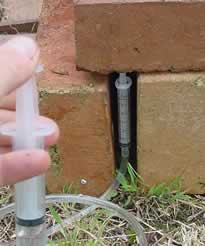Hydraulic activity.
Force control through liquids.

Robots welding parts on a car assembly line.

Stephen is holding two different sized syringes filled with water and connected via tubing.

Stephen has set up this simple activity in order to see if the small syringe is better at lifting the brick than the large one.
How far does the plunger of the big syringe move out when the small syringe is pushed in 4 cms?
Ask your friends to place their thumb over one of the plungers and try to stop it from moving outwards while you press down on the other. Which syringe, the 2.5 cm3 or 10 cm3, will you use to push your friends thumb upwards?
Construct a machine that can be used to scoop sweets from a bucket into another bucket. This machine must be operated remotely by hydraulic pressure, consist of at least two levers and rotate no less than 90o
Draw to scale our design. Label all the levers that make up your machine. Identify these levers as first, second or third order and discuss if they are force or ditance multipliers.
Describe how your turning mechanism works.

An example of a machine that operates remotely by hydraulic means.
Two syringes are used to control a lever as shown on the right.
Is force or distance multiplied as syringe A is pushed in?

